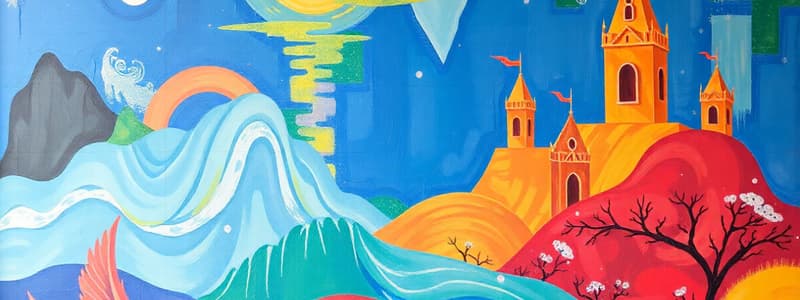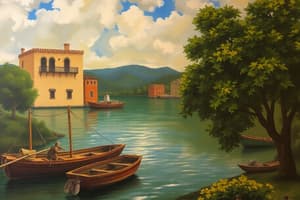Podcast
Questions and Answers
¿Qué técnica de pintura mural requiere una preparación previa de la superficie?
¿Qué técnica de pintura mural requiere una preparación previa de la superficie?
- Acrílica
- Látex
- Temple (correct)
- Aerosol
¿Qué material se utiliza en la pintura mural del siglo XIX además del temple?
¿Qué material se utiliza en la pintura mural del siglo XIX además del temple?
- Acrílico (correct)
- Témpera
- Acuarela
- Óleo
¿Cuál es el objetivo principal de los murales según el contenido?
¿Cuál es el objetivo principal de los murales según el contenido?
- Vender arte
- Realizar exposiciones
- Decorar espacios
- Transmitir mensajes (correct)
¿En qué periodo se relacionan los ismos con movimientos sociales?
¿En qué periodo se relacionan los ismos con movimientos sociales?
¿Cuál es una ventaja de utilizar pintura acrílica en murales?
¿Cuál es una ventaja de utilizar pintura acrílica en murales?
¿Qué características tienen los murales movibles?
¿Qué características tienen los murales movibles?
¿Qué movimiento social se asocia notablemente con los ismos en el arte?
¿Qué movimiento social se asocia notablemente con los ismos en el arte?
¿Cuál de las siguientes no es una técnica de pintura mural mencionada?
¿Cuál de las siguientes no es una técnica de pintura mural mencionada?
¿Cuál fue una de las características del impresionismo?
¿Cuál fue una de las características del impresionismo?
¿Qué aspecto se prioriza en el romanticismo?
¿Qué aspecto se prioriza en el romanticismo?
¿Qué movimiento cultural surgió como reacción al Neoclasicismo?
¿Qué movimiento cultural surgió como reacción al Neoclasicismo?
¿Cuál de los siguientes artistas está asociado con el realismo?
¿Cuál de los siguientes artistas está asociado con el realismo?
¿Qué crítica social se aborda en el realismo?
¿Qué crítica social se aborda en el realismo?
¿Qué aspecto de la vida se centra el realismo?
¿Qué aspecto de la vida se centra el realismo?
¿Qué resultó de la transformación social durante el impresionismo?
¿Qué resultó de la transformación social durante el impresionismo?
¿Cuál de las siguientes manifestaciones artísticas se considera parte de la cultura moderna que surgió en el siglo XX?
¿Cuál de las siguientes manifestaciones artísticas se considera parte de la cultura moderna que surgió en el siglo XX?
¿Cuál de las siguientes características es propia del impresionismo?
¿Cuál de las siguientes características es propia del impresionismo?
¿Qué aspecto se rechaza en el simbolismo?
¿Qué aspecto se rechaza en el simbolismo?
¿Qué técnica caracteriza al postimpresionismo?
¿Qué técnica caracteriza al postimpresionismo?
¿Cuál era el propósito del futurismo según Marinetti?
¿Cuál era el propósito del futurismo según Marinetti?
¿Qué técnica se abandona en el postimpresionismo?
¿Qué técnica se abandona en el postimpresionismo?
¿Qué temática NO se asocia típicamente con el simbolismo?
¿Qué temática NO se asocia típicamente con el simbolismo?
¿Quién es un artista destacado del expresionismo?
¿Quién es un artista destacado del expresionismo?
¿Qué fenómeno social busca representar el futurismo?
¿Qué fenómeno social busca representar el futurismo?
¿Cuál es una de las características del arte que prioriza la expresión y los sentimientos?
¿Cuál es una de las características del arte que prioriza la expresión y los sentimientos?
¿Qué artistas destacan en el contexto del arte que se centra en el sentimiento y el caos?
¿Qué artistas destacan en el contexto del arte que se centra en el sentimiento y el caos?
¿Cuál es la principal utilidad de las pátinas en la decoración?
¿Cuál es la principal utilidad de las pátinas en la decoración?
¿Cuál fue una de las grandes revoluciones en el arte del siglo XX?
¿Cuál fue una de las grandes revoluciones en el arte del siglo XX?
¿Qué disciplina artística se desarrolla a través de acciones realizadas por el artista o participantes?
¿Qué disciplina artística se desarrolla a través de acciones realizadas por el artista o participantes?
¿Qué corriente artística utiliza materiales naturales para recrear paisajes?
¿Qué corriente artística utiliza materiales naturales para recrear paisajes?
¿Cuál es una característica clave de las instalaciones en el arte contemporáneo?
¿Cuál es una característica clave de las instalaciones en el arte contemporáneo?
¿Cuál de los siguientes elementos NO es considerado básico en una performance?
¿Cuál de los siguientes elementos NO es considerado básico en una performance?
¿Qué efecto se busca al aplicar una segunda pátina después de 10/15 minutos?
¿Qué efecto se busca al aplicar una segunda pátina después de 10/15 minutos?
¿Qué concepto desafió Marcel Duchamp al presentar un urinario como obra de arte?
¿Qué concepto desafió Marcel Duchamp al presentar un urinario como obra de arte?
¿Cuál es el propósito del arte en el contexto del Land Art?
¿Cuál es el propósito del arte en el contexto del Land Art?
¿Cuál es el objetivo principal de una performance?
¿Cuál es el objetivo principal de una performance?
¿Qué tipo de expresión artística utiliza el cuerpo humano como soporte o vehículo?
¿Qué tipo de expresión artística utiliza el cuerpo humano como soporte o vehículo?
¿Cuál es una técnica recomendada para aplicar pátinas eficientemente?
¿Cuál es una técnica recomendada para aplicar pátinas eficientemente?
¿Qué característica especial tiene el arte de la performance en comparación con otras disciplinas artísticas?
¿Qué característica especial tiene el arte de la performance en comparación con otras disciplinas artísticas?
¿Cuál de las siguientes afirmaciones sobre las vanguardias artísticas del siglo XX es correcta?
¿Cuál de las siguientes afirmaciones sobre las vanguardias artísticas del siglo XX es correcta?
Flashcards
Mural Painting
Mural Painting
Two-dimensional paintings applied directly to walls, ceilings, or large surfaces like cardboard or wood.
Mural Technique
Mural Technique
Methods for creating murals, evolving from ancient times (like tempera) to modern techniques (like latex, acrylic, spray paint).
Tempera Muralism
Tempera Muralism
An older painting technique that demands careful surface preparation before application; now less common.
Social/Community Mural
Social/Community Mural
Signup and view all the flashcards
Artistic Isms
Artistic Isms
Signup and view all the flashcards
Industrial Revolution
Industrial Revolution
Signup and view all the flashcards
Spray Paint
Spray Paint
Signup and view all the flashcards
Acrylic Paint
Acrylic Paint
Signup and view all the flashcards
20th Century Art Changes
20th Century Art Changes
Signup and view all the flashcards
Conceptual Art
Conceptual Art
Signup and view all the flashcards
Romanticism
Romanticism
Signup and view all the flashcards
Realism (Art)
Realism (Art)
Signup and view all the flashcards
Impressionism
Impressionism
Signup and view all the flashcards
Historical Context
Historical Context
Signup and view all the flashcards
Photography's Role
Photography's Role
Signup and view all the flashcards
Artistic Isms
Artistic Isms
Signup and view all the flashcards
Impressionism
Impressionism
Signup and view all the flashcards
Symbolism
Symbolism
Signup and view all the flashcards
Post-Impressionism
Post-Impressionism
Signup and view all the flashcards
Futurism
Futurism
Signup and view all the flashcards
Expressionism (art)
Expressionism (art)
Signup and view all the flashcards
Impressionism's Impact (art)
Impressionism's Impact (art)
Signup and view all the flashcards
Post-Impressionism Subjects
Post-Impressionism Subjects
Signup and view all the flashcards
Futurism Artists Influence
Futurism Artists Influence
Signup and view all the flashcards
Subjective Expressionism
Subjective Expressionism
Signup and view all the flashcards
Land Art
Land Art
Signup and view all the flashcards
Installation Art
Installation Art
Signup and view all the flashcards
Patina in Sculpture
Patina in Sculpture
Signup and view all the flashcards
Patina Application
Patina Application
Signup and view all the flashcards
War's Impact on Art
War's Impact on Art
Signup and view all the flashcards
Contemporary Art Trends
Contemporary Art Trends
Signup and view all the flashcards
Purpose of Patina
Purpose of Patina
Signup and view all the flashcards
20th Century Art Changes
20th Century Art Changes
Signup and view all the flashcards
Conceptual Art
Conceptual Art
Signup and view all the flashcards
Performance Art
Performance Art
Signup and view all the flashcards
Body Art
Body Art
Signup and view all the flashcards
Marcel Duchamp
Marcel Duchamp
Signup and view all the flashcards
Vanguards
Vanguards
Signup and view all the flashcards
Time and Space (in art)
Time and Space (in art)
Signup and view all the flashcards
Artist and Public (performance)
Artist and Public (performance)
Signup and view all the flashcards
Study Notes
Pintura Mural
- Murales son pinturas bidimensionales en paredes, muros o techos.
- Pueden ser elaborados en otros soportes grandes (cartón, madera).
- Tienen un propósito educativo, informativo o sensibilizador.
- La técnica mural tiene una larga historia, desde la época paleolítica.
- La técnica "temple" requería una preparación previa de la superficie.
- Técnicas modernas usan aerosol de pintura acrílica, siendo más rápidas y fáciles.
- La pintura mural actual considera las condiciones del espacio.
- La importancia de los murales en la sociedad es su capacidad de comunicar mensajes sociales.
- Los murales expresan ideas y emociones a través de la comunicación visual.
- Se pueden utilizar en temas de derechos humanos para una expresión artística.
Historia del Arte: "Los Ismos"
- Los "ismos" en el arte están relacionados con los movimientos sociales de cada época.
- La Revolución Industrial influenció movimientos como el Romanticismo.
- El Romanticismo enfatizó los sentimientos y lo individual.
- El Realismo buscaba una representación objetiva de la realidad.
- El Impresionismo se caracterizó por la experimentación con la luz.
- El Simbolismo se alejaba de la representación real, buscando lo espiritual y simbólico.
- El Postimpresionismo reflejó los cambios sociales con pinceladas precisas y colores vivos.
- El Futurismo intentó representar la dinámica de la vida moderna.
- El Expresionismo se enfocaba en la expresión subjetiva, con colores intensos.
Studying That Suits You
Use AI to generate personalized quizzes and flashcards to suit your learning preferences.




